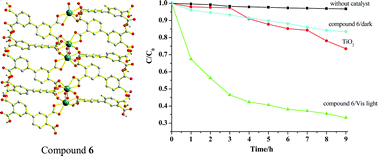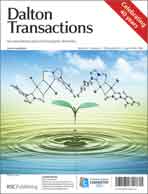Six new metal–organic frameworks [Cu(obba)(bimb)·(obbaH2)]n (1), [Cu(obba)(bimb)]n (2), [Zn2(obba)2(bimb)2(DMF)2(H2O)3.5]n (3), [Ni3(2,2′,4,4′-bptcH)2(bimb)2(H2O)2·(H2O)2]n (4), [Ni2(bimb)3(H2O)6·(aobtc)·(DMF)2·(H2O)2]n (5) and [Cd(3,3′,4,4′-bptcH2)(H2O)·(bimb)]n (6), were obtained by reactions of 4,4′-bis(1-imidazolyl)biphenyl (bimb) and multi-carboxylic acids of 4,4′-oxybis(benzoic acid) (obbaH2), 2,2′,4,4′-biphenyltetracarboxylate acid (2,2′,4,4′-bptcH4), azoxybenzene-3,3′,5,5′-tetracarboxylic acid (aobtcH4), and 3,3′,4,4′-biphenyltetracarboxylate acid (3,3′,4,4′-bptcH4) with corresponding metal salts under hydro/solvothermal conditions, respectively. Complexes 1–3 have entangled structures with different topologies: 1 is a 3-fold interpenetrating NbO three-dimensional (3D) network; 2 is a 3-fold interpenetrating dmp 3D net; 3 is a 6-fold interpenetrating dia 3D chiral net containing rare 1D helical chains with the same handedness. Complex 4 is an uninodal 6-connected network with a Schäfli symbol of (486483) based on the trinuclear Ni(II) subunits, while complexes 5 and 6 are 1D chains. Interestingly, compound 6 represents the rare example of MOFs that exhibit high photocatalytic activity for dye degradation under visible light and shows good stability towards photocatalysis. Complexes 3 and 6 exhibit intense blue emissions in the solid state at room temperature whereas 3 appears to be a good candidate of novel hybrid inorganic–organic NLO material.


 Please wait while we load your content...
Please wait while we load your content...